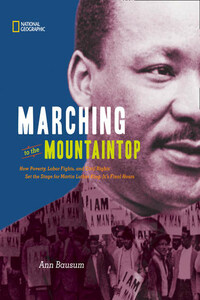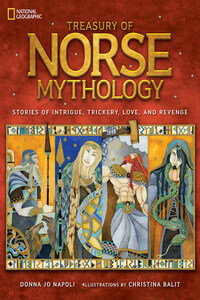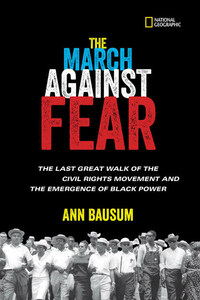The publisher and author gratefully acknowledge the review of proofs for this book by historian Michael K. Honey. For more information on the topic, consult Professor Honey’s definitive, award-winning account of the history, Going Down Jericho Road: The Memphis Strike, Martin Luther King’s Last Campaign (W. W. Norton & Company, 2007).
Published by the National Geographic Society John M. Fahey, Jr., CHAIRMAN OF THE BOARD AND CHIEF EXECUTIVE OFFICER Timothy T. Kelly, PRESIDENT Declan Moore, EXECUTIVE VICE PRESIDENT; PRESIDENT, PUBLISHING Melina Gerosa Bellows, EXECUTIVE VICE PRESIDENT; CHIEF CREATIVE OFFICER, BOOKS, KIDS, AND FAMILY
Prepared by the Book Division Nancy Laties Feresten, SENIOR VICE PRESIDENT, EDITOR IN CHIEF, CHILDREN’S BOOKS Jonathan Halling, DESIGN DIRECTOR, BOOKS AND CHILDREN’S PUBLISHING Jay Sumner, DIRECTOR OF PHOTOGRAPHY, CHILDREN’S PUBLISHING Jennifer Emmett, EDITORIAL DIRECTOR, CHILDREN’S BOOKS Carl Mehler, DIRECTOR OF MAPS R. Gary Colbert, PRODUCTION DIRECTOR Jennifer A. Thornton, MANAGING EDITOR
Staff for This Book Jennifer Emmett, PROJECT EDITOR Eva Absher, ART DIRECTOR Lori Epstein, SENIOR ILLUSTRATIONS EDITOR Marty Ittner, DESIGNER Grace Hill, ASSOCIATE MANAGING EDITOR Joan Gossett, PRODUCTION EDITOR Lewis R. Bassford, PRODUCTION MANAGER Susan Borke, LEGAL AND BUSINESS AFFAIRS Kate Olesin, EDITORIAL ASSISTANT Kathryn Robbins, DESIGN PRODUCTION ASSISTANT Hillary Moloney, ILLUSTRATIONS ASSISTANT
Manufacturing and Quality Management Christopher A. Liedel, CHIEF FINANCIAL OFFICER Phillip L. Schlosser, SENIOR VICE PRESIDENT Chris Brown, TECHNICAL DIRECTOR Nicole Elliott, MANAGER Rachel Faulise, MANAGER Robert L. Barr, MANAGER
COVER: The cover illustration combines a view taken of Martin Luther King, Jr., on the day before his death with a scene of striking Memphis workers before the attempted protest of March 28, 1968. Endpapers replicate popular protest signs from Memphis civil rights events in 1968. Pickets march past armed troops on March 29, 1968 (title page). Garbage accumulates in the street of an African-American neighborhood in 1968 (table of contents).
The National Geographic Society is one of the world’s largest nonprofit scientific and educational organizations. Founded in 1888 to “increase and diffuse geographic knowledge,” the Society works to inspire people to care about the planet. National Geographic reflects the world through its magazines, television programs, films, music and radio, books, DVDs, maps, exhibitions, live events, school publishing programs, interactive media and merchandise.
National Geographic magazine, the Society’s official journal, published in English and 33 local-language editions, is read by more than 38 million people each month. The National Geographic Channel reaches 320 million households in 34 languages in 166 countries. National Geographic Digital Media receives more than 15 million visitors a month. National Geographic has funded more than 9,400 scientific research, conservation and exploration projects and supports an education program promoting geography literacy. For more information, visit
nationalgeographic.com.
For more information, please call 1-800-NGS LINE
(647-5463) or write to the following address:
National Geographic Society
1145 17th Street N.W.
Washington, D.C. 20036-4688 U.S.A.
Visit us online at www.nationalgeographic.com/books
For librarians and teachers: www.ngchildrensbooks.org More for kids from National Geographic: kids.nationalgeographic.com
For rights or permissions inquiries, please contact National Geographic Books Subsidiary Rights: ngbookrights@ngs.org
Library of Congress Cataloging-in-Publication Data Bausum, Ann. Marching to the mountaintop : how poverty, labor fights, and civil rights set the stage for Martin Luther King, Jr.’s final hours / by Ann Bausum. — 1st ed. p. cm. Includes bibliographical references. eISBN: 978-1-4263-0945-8 1. King, Martin Luther, Jr., 1929-1968—Juvenile literature. 2. King, Martin Luther, Jr., 1929-1968—Assassination—Juvenile literature. 3. Sanitation Workers Strike, Memphis, Tenn., 1968—Juvenile literature. 4. Labor movement—Tennessee—Memphis—History—20th century—Juvenile literature. 5. African Americans—Tennessee—Memphis—Social conditions—20th century—Juvenile literature. 6. Memphis (Tenn.)—Race relations—History—20th century—Juvenile literature. I. Title. E185.97.K5B38 2012 323.092–dc23 [B] 2011024661
Text copyright © 2012 Ann Bausum.
Compilation copyright © 2012 National Geographic Society.
All rights reserved. Reproduction of the whole or any part of the contents without written permission from the publisher is prohibited.
v3.1
Version: 2017-07-05










